Leonids 2002Leonids 2002
For the Leonids 2002 shower, the best peak was going to be in North
America, so we stayed close to home. Like many we went to the most
popular observing site for Bay Area astronomers, Fremont Peak near
Salinas/Monterey California, home of an observatory with 30" reflector.
The prior year people reported a huge crowd, this year the crowd was quite
light. Campgrounds filled, and probably 100 people were there, only about
20 at the actual observatory where I set up. Of course the full moon
was the impediment, but we came to high altitude to help reduce that.
This year's show was not nearly as good as 2001. In 2001, we journeyed
to Japan to get the superior Asian peak.
The show was astounding, with a ZHR of at least 7,000 or more. While
my photos of the 2001 Leonids were
damaged in developing, they were astounding. Each 3 minute film shot in
2001 had multiple meteors. Several shots had 10 or more, I had one shot
with 20, all from a 5 minute exposure. Meteor photographers will realize
just how astounding that is. One digital 20 second shot with 80mm field of
view had 3 meteors.
This year the show peaked with a ZHR probably in the 800 range. The peak
was very brief, around 2:30 to 3am Pacific. Quickly after that the show
became more mundane. We didn't personally do any scientific counts,
unfortunately. Due to the need for shorter exposures with the moonlight,
too much time was spent worrying about cameras. However, counts were easily
10-15 per minute during the peak times.
For photography I had 3 cameras. The Canon D60 with 17mm/2.8 lens shot 30
second exposures at 800 speed constantly all night. The film body shot
Superia 800 in 2 minute exposures with a Canon 16mm/2.8L lens. A Pentax
P&S shot Superia 800 and Kodak HIE infrared film. (Still waiting on the
latter.)
I got about 33 meteor shots with the D60, which is pretty incredible when
you consider that an ordinary night of meteor photography gets 1 or 2.
I only got 15 shots with meteors on the film, which at 2 minutes was already
getting pretty washed out with the moonlight. The most I saw in any
single frame was 3. Only a few fireballs were caught.
2001 had bright meteors all night, though of course the peak, at 2 per
second, was astounding. So I guess I am spoiled!
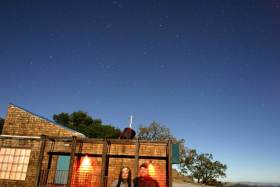 | selfport.jpg
(1280 x 853 - 100K) |
A self portrait of Brad and Kathryn in front of Fremont Peak observatory. 30 second D60 exposure @ 17mm -- two leonids flash behind us, near end of storm.
| |
|
 | fireball.jpg
(1280 x 853 - 86K) |
Brilliant fireball left a trail for 8 minutes (see others). Look closely for another fainter meteor in same shot.
| |
 | trail.jpg
(1280 x 853 - 111K) |
30 seconds later, the trail for the fireball is still giant
|
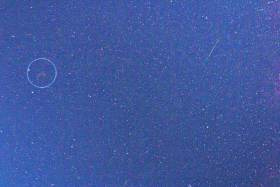 | twotrail7.jpg
(1280 x 853 - 240K) |
7 minutes after the fireball, this enhanced shot shows the cloud still dispersing, and two leonids streaking in the area. 30 second exposure
| |
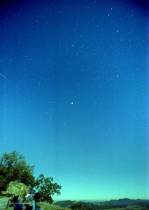 | leo3.jpg
(725 x 1024 - 86K) |
Three (actually 4) Leonids streak from Leo as observers watch on Fremont Peak, California
|
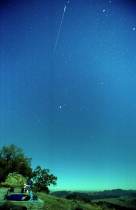 | leoball.jpg
(664 x 1024 - 76K) |
Observers awe at a bright Leonid Fireball
| |
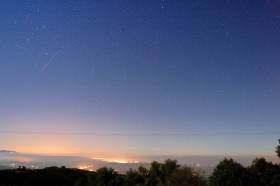 | gilroy.jpg
(1280 x 851 - 101K) |
Leonid falls over Gilroy, CA, with glow of San Francisco in background
|
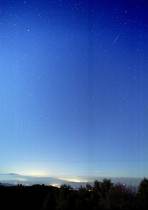 | gilroy2.jpg
(721 x 1024 - 67K) |
Another leonid falls high over fog-shrouded Gilroy and Holister valley
| |
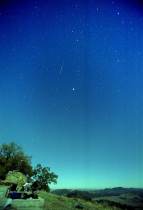 | leosolo.jpg
(696 x 1024 - 80K) |
A solo Leonid right at the radiant
|
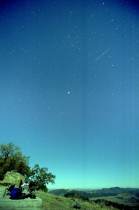 | leobright.jpg
(677 x 1024 - 75K) |
Another fireball flares close to Leo
| |
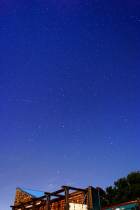 | obsursa.jpg
(683 x 1024 - 56K) |
A solo meteor sails through Ursa Major over Fremont Peak Observatory
|
 | fb2.jpg
(1280 x 853 - 131K) |
Fireball in sky over big dipper changes colour
| |
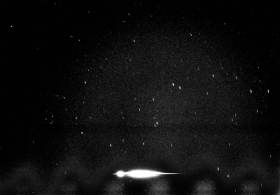 | irball.jpg
(1280 x 890 - 157K) |
Caught the same fireball on infrared film. It was very bright in IR. Glows at bottom are from infrared LED inside camera counting sprocket holes. :-(
|
Some notes about our site and other matters.
Fremont Peak is about 2750 feet up, between Salinas and Hollister near
Monterey in California. It's about 90 minutes drive for astronomers
in the otherwise highly light polluted SF Bay Area. It gets its darkest
skies when there is a fog below the peak that blocks out all the city lights,
but it generally has high quality dark skies. There is a 30" scope there
and the rangers are very astronomy friendly.
Stories went that during the 2001 Leonids the peak was packed, and not long
after dark people could not even drive in, they had to park further down
and hike up. Due to those warnings, we arrived early but there was no big
crowd and we got a campsite, though not in a clear area.
Many of the photos here came from the Canon D60 camera. The D60 is amazing,
and even when warm does not have much noise. It is easily able to shoot
a 30 second exposure and ISO 800. This is similar to a 90 second film
exposure due to the reciprocity failure of most films, though of course
for meteors that's actually bad.
In fact, it can shoot up to about 2 minutes but it starts getting a purple
glow from internal heat. Still, pretty amazing at 6 million pixels. There
is noise, so you can't get all that resolution out, but I wanted 800 ISO
to catch the fainter meteors.
I went back and forth a lot over what film to use. I tried Superia 400
thinking it had bad reciprocity failure (which is not failure at all for
meteor shooting) but later the tables I found said only the 800 had failure
of 2 stops to get 64 seconds. (ie 256 seconds is like 64 seconds with
no failure.) However, the 400 speed had too much light fog at about 4 minutes,
so I stuck to 2 minutes. I will probably not do this again, but if I do
I will hunt the film with the greatest reciprocity failure I can find.
The nice thing about the digital is you can automate it. I just pointed it
at the sky, set it for 30 second exposures and locked down the cable
release. It just keeps shooting until the CF card fills up or battery
dies. That happened a few times because ISO-800 shots with high noise make
very big jpegs. Raw would be even bigger, and would be recommended if you
had a 1GB microdrive.
Kathryn's old P&S camera also could do automated shooting, but at 2 minutes
per shot at f/3.5. Unfortunately, wide open like that her camera had
terrible light fall-off and so didn't turn out well.
As noted, the fiddling to do the 2 minute exposures by hand made me focus
on that and watching, not counting.
The moonlight of course caused all this trouble, but it did mean that
many of the scenes show the people on the ground and hills to be brightly
lit, which is a nice effect. It's interesting how the moonlight turns the
sky blue in long exposures, which I guess should not be surprising.
Later that night after we got back to our tent, we looked up, and the
space station passed almost dirctly overhead. We hadn't even stopped to
check if it was passing.












